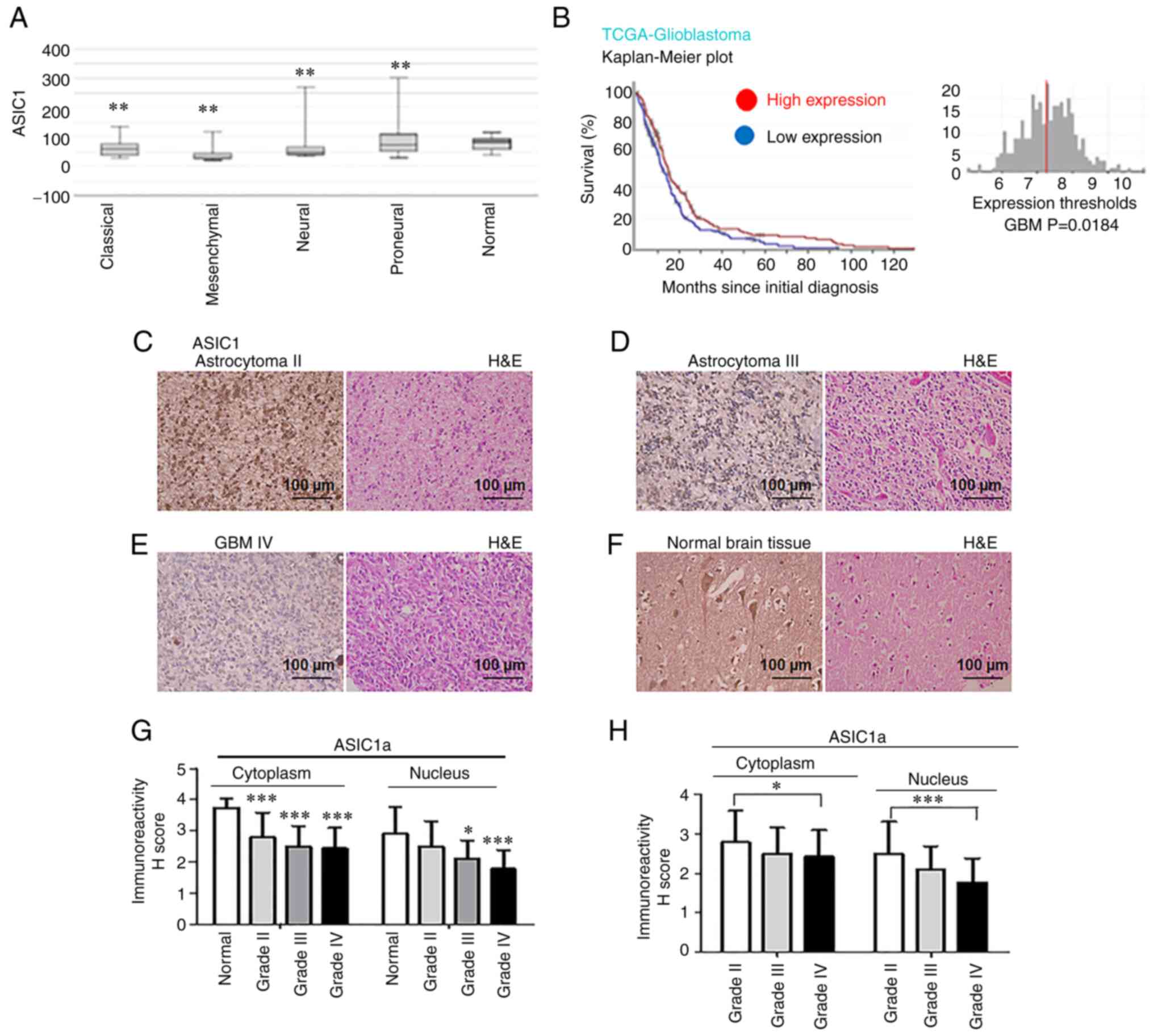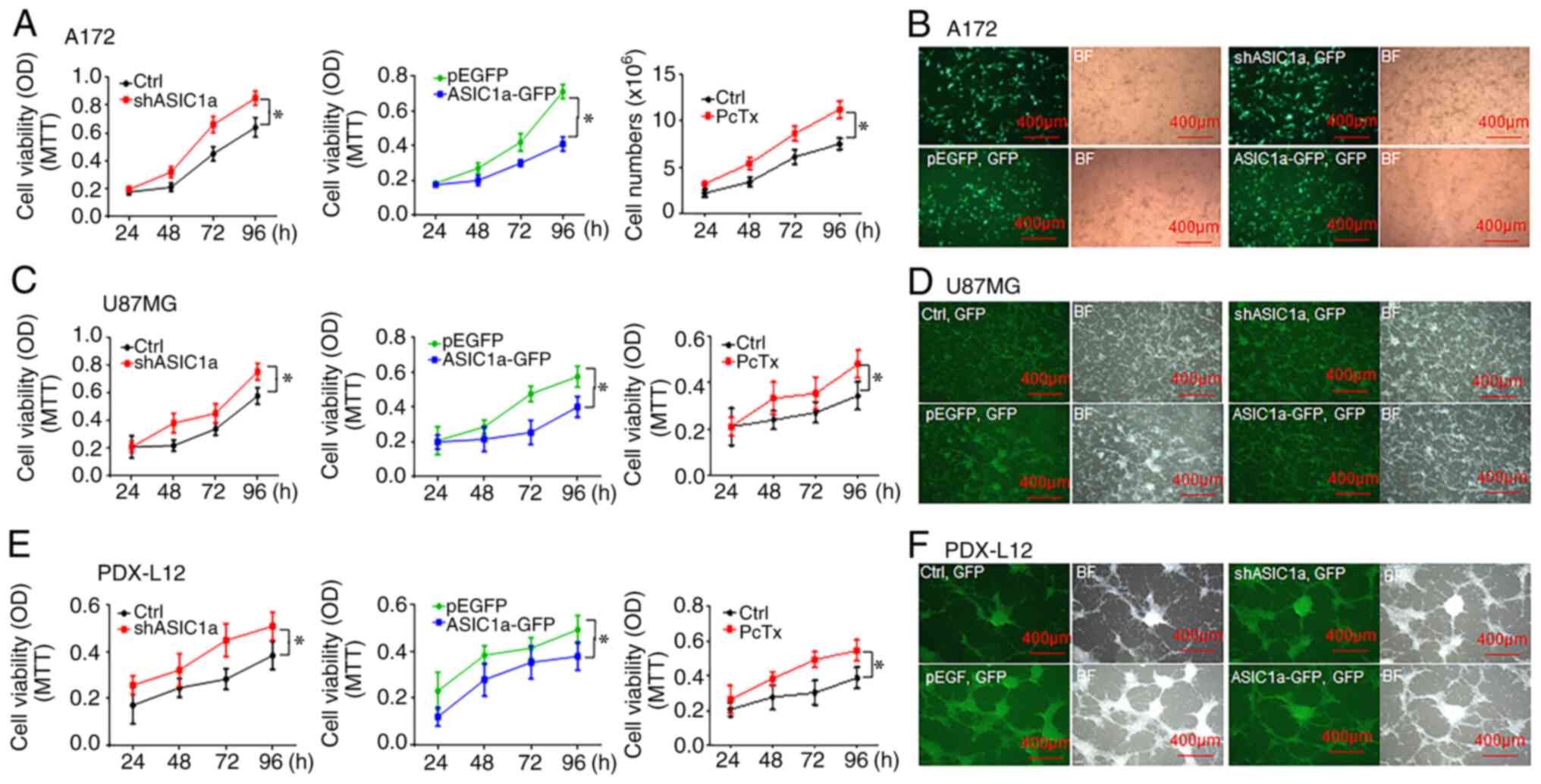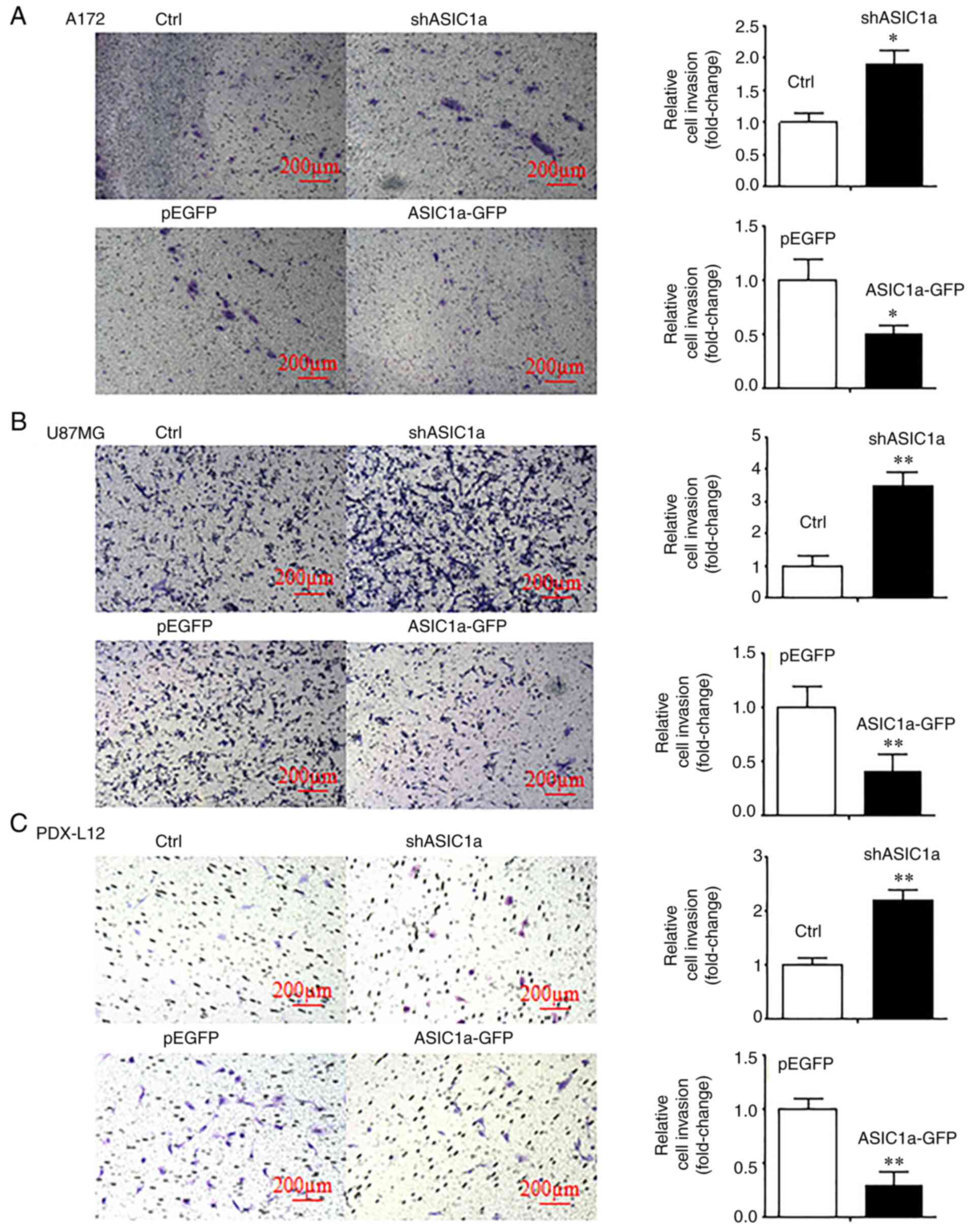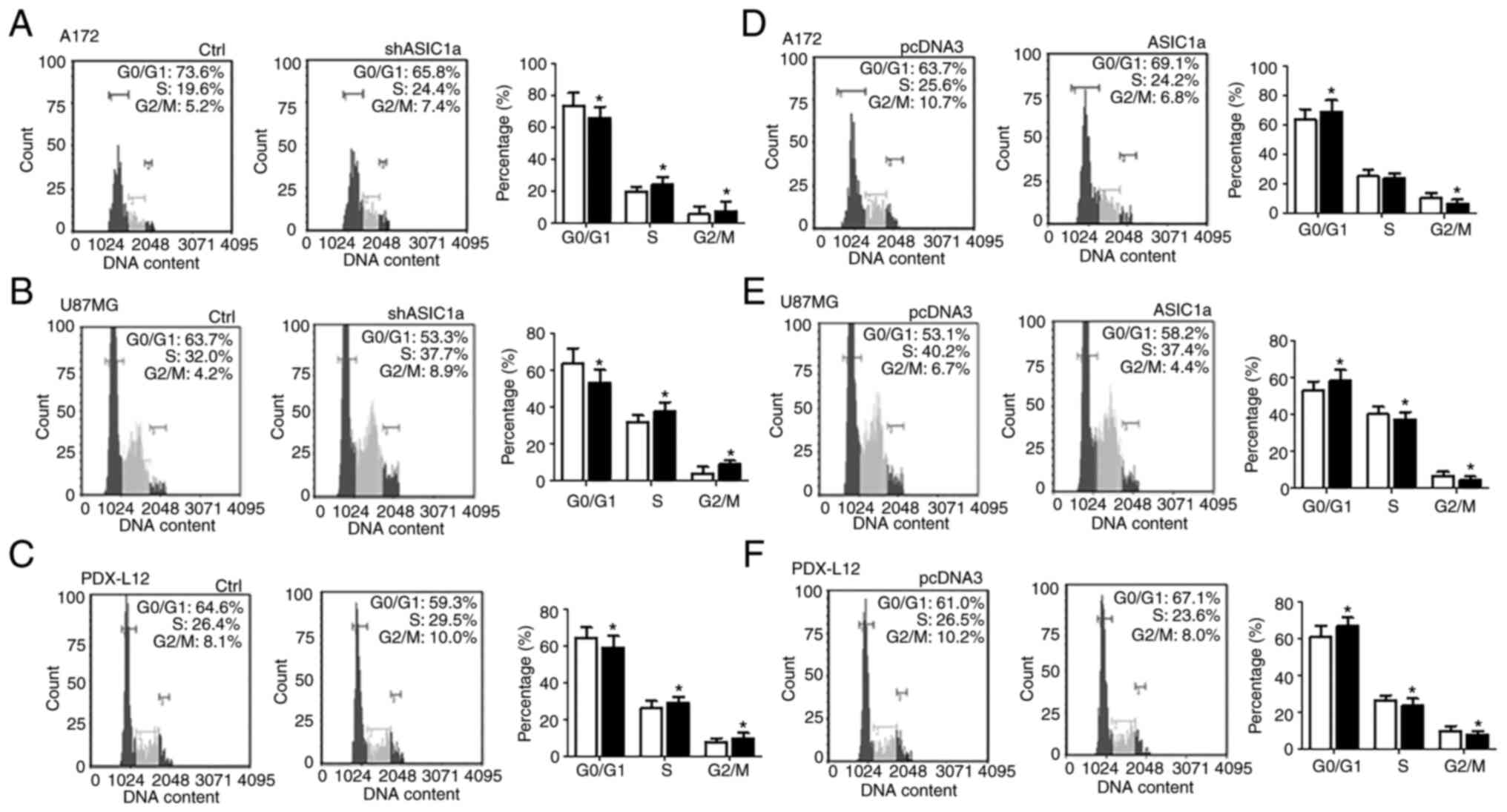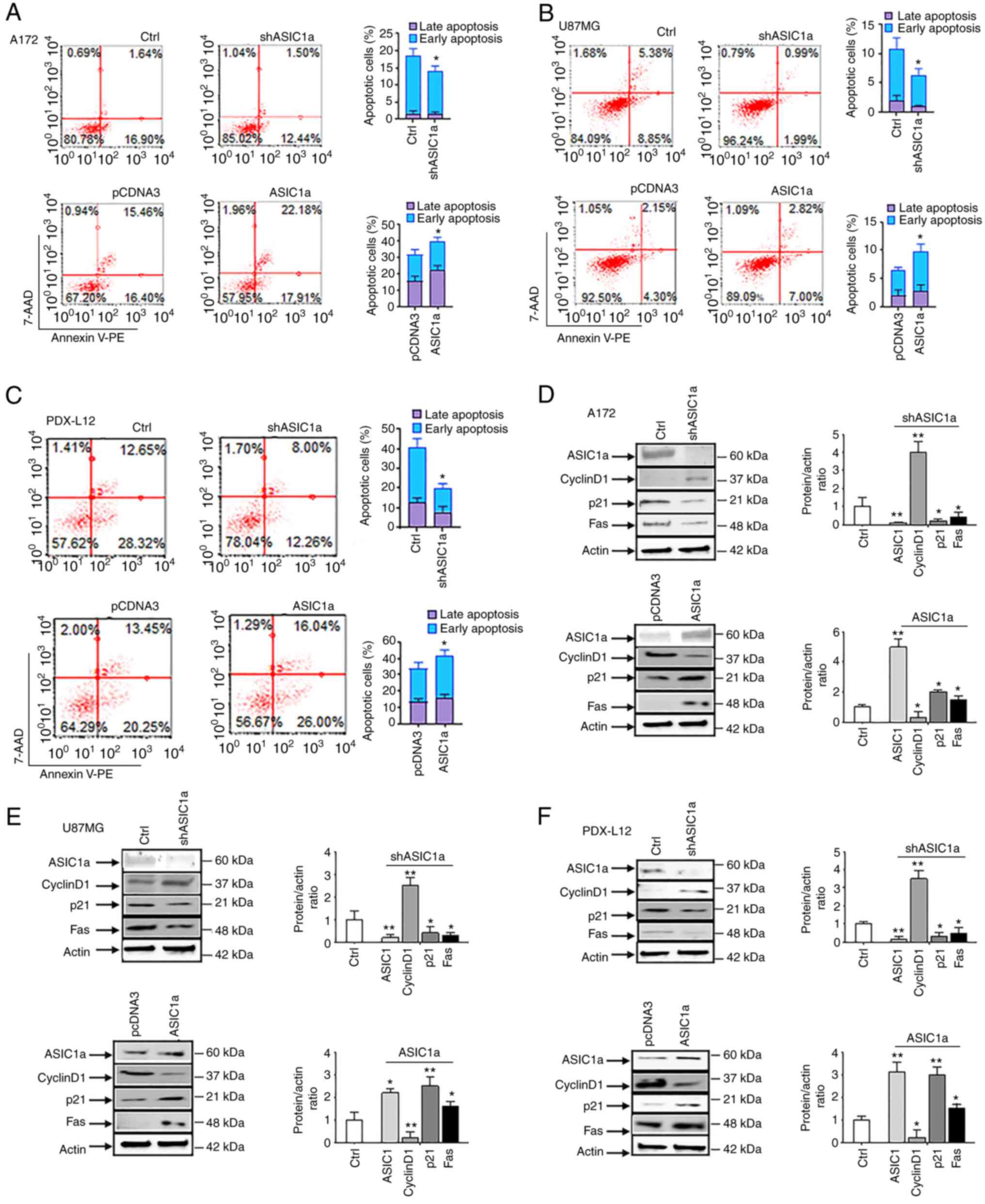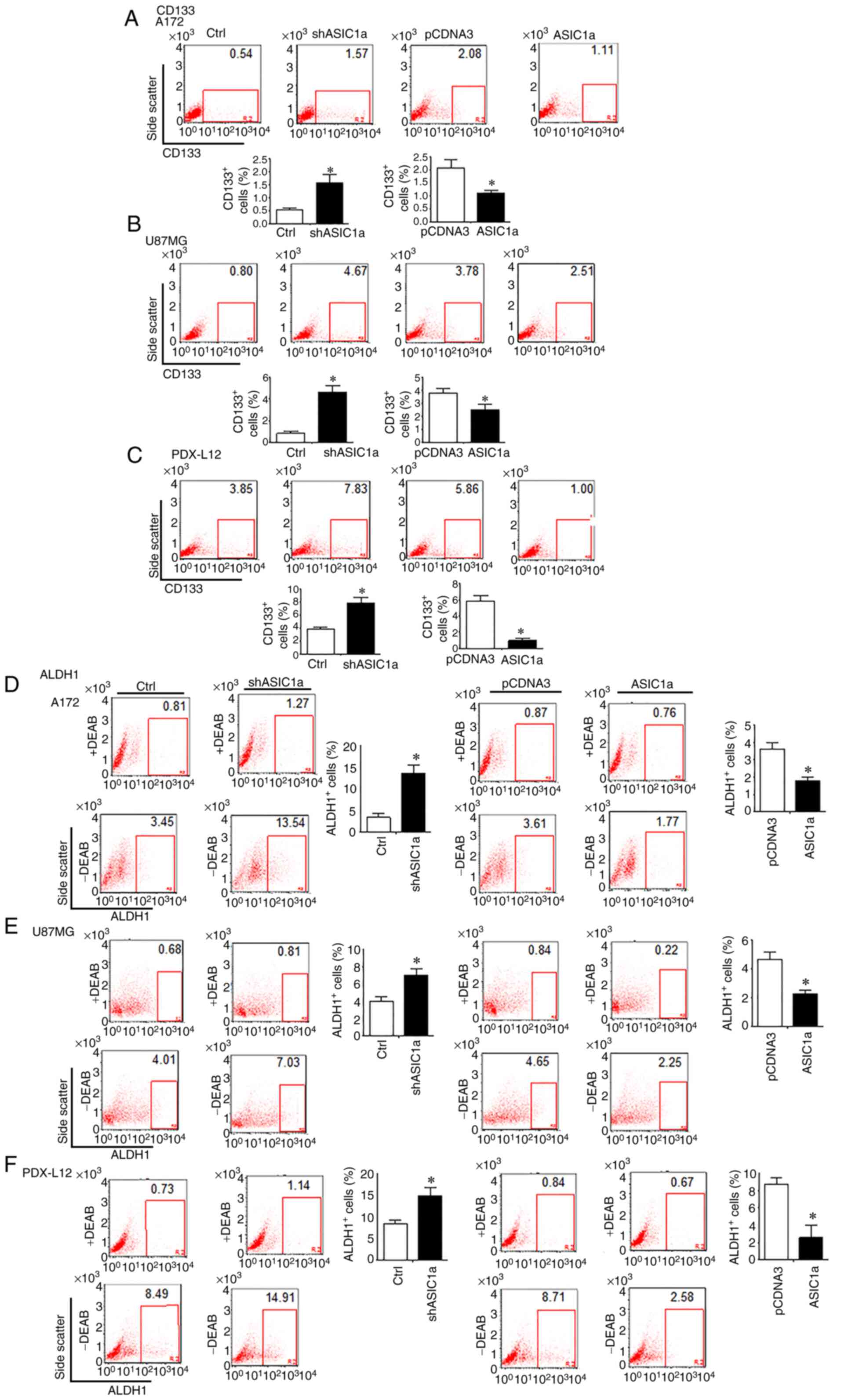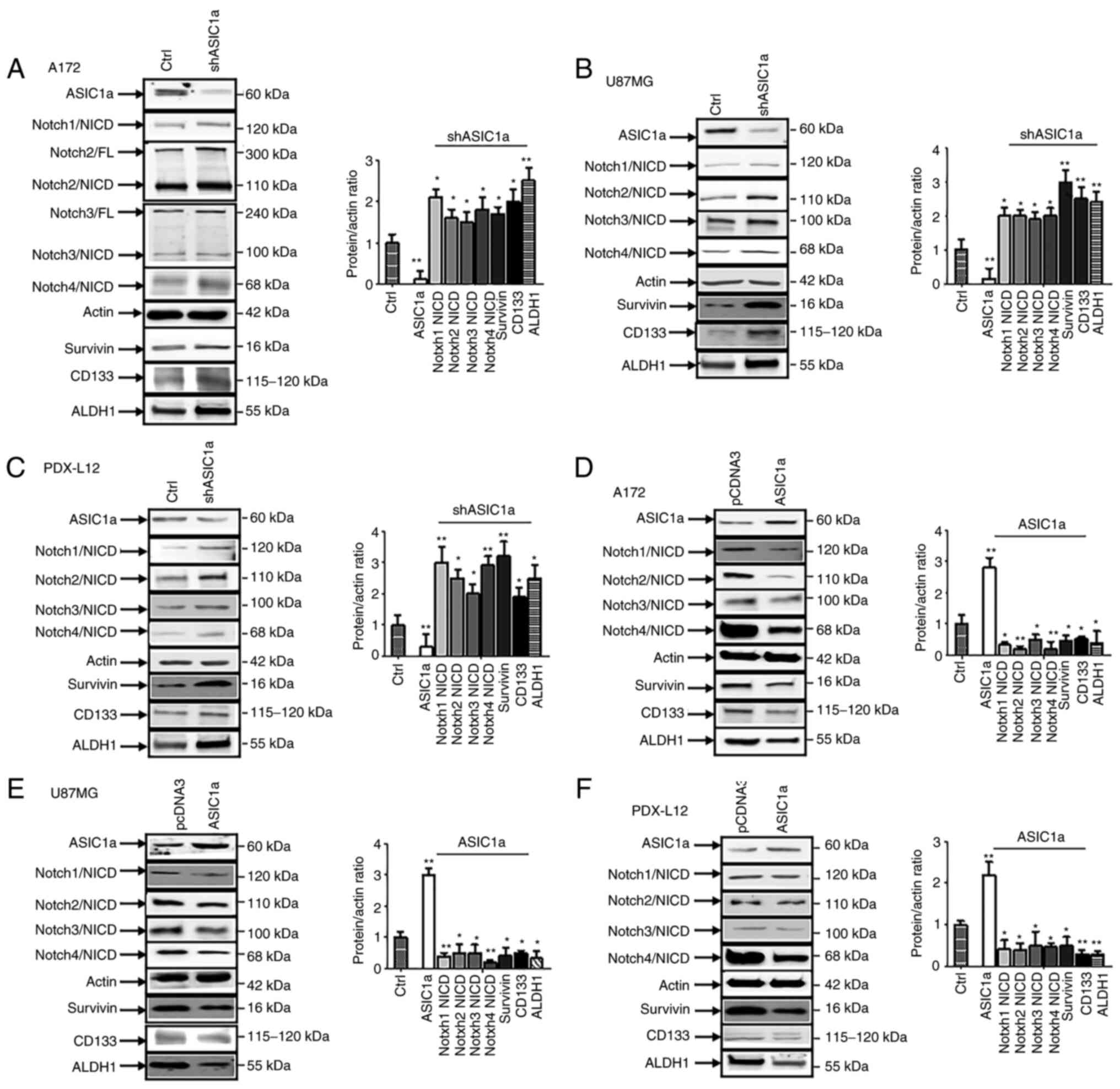|
1
|
Louis DN, Perry A, Reifenberger G, von
Deimling A, Figarella- Branger D, Cavenee WK, Ohgaki H, Wiestler
OD, Kleihues P and Ellison DW: The 2016 World Health Organization
classification of tumors of the central nervous system: A summary.
Acta Neuropathol. 131:803–820. 2016. View Article : Google Scholar
|
|
2
|
Damaghi M, Wojtkowiak JW and Gillies RJ:
pH sensing and regulation in cancer. Front Physiol. 4:3702013.
View Article : Google Scholar
|
|
3
|
Lee WY, Huang SC, Hsu KF, Tzeng CC and
Shen WL: Roles for hypoxia-regulated genes during cervical
carcinogenesis: Somatic evolution during the
hypoxia-glycolysis-acidosis sequence. Gynecol Oncol. 108:377–384.
2008. View Article : Google Scholar
|
|
4
|
Ward G, Meehan J, Gray ME, Murray AF,
Argyle DJ, Kunkler IH and Langdon SP: The impact of tumor pH on
cancer progression: Strategies for clinical intervention. Explor
Target Antitumor Ther. 1:71–100. 2020. View Article : Google Scholar
|
|
5
|
Xiong ZG, Chu XP and Simon RP: Acid
sensing ion channels-novel therapeutic targets for ischemic brain
injury. Front Biosci. 12:1376–1386. 2007. View Article : Google Scholar
|
|
6
|
Berdiev BK, Xia J, McLean LA, Markert JM,
Gillespie GY, Mapstone TB, Naren AP, Jovov B, Bubien JK, Ji HL, et
al: Acid-sensing ion channels in malignant gliomas. J Biol Chem.
278:15023–15034. 2003. View Article : Google Scholar
|
|
7
|
Kapoor N, Bartoszewski R, Qadri YJ, Bebok
Z, Bubien JK, Fuller CM and Benos DJ: Knockdown of ASIC1 and
epithelial sodium channel subunits inhibits glioblastoma whole cell
current and cell migration. J Biol Chem. 284:24526–24541. 2009.
View Article : Google Scholar
|
|
8
|
Kapoor N, Lee W, Clark E, Bartoszewski R,
McNicholas CM, Latham CB, Bebok Z, Parpura V, Fuller CM, Palmer CA
and Benos DJ: Interaction of ASIC1 and ENaC subunits in human
glioma cells and rat astrocytes. Am J Physiol Cell Physiol.
300:C1246–C1259. 2011. View Article : Google Scholar
|
|
9
|
Rooj AK, Liu Z, McNicholas CM and Fuller
CM: Physical and functional interactions between a glioma cation
channel and integrin-β1 require α-actinin. Am J Physiol Cell
Physiol. 309:C308–C319. 2015. View Article : Google Scholar
|
|
10
|
Rooj AK, McNicholas CM, Bartoszewski R,
Bebok Z, Benos DJ and Fuller CM: Glioma-specific cation conductance
regulates migration and cell cycle progression. J Biol Chem.
287:4053–4065. 2012. View Article : Google Scholar
|
|
11
|
Tian Y, Bresenitz P, Reska A, El Moussaoui
L, Beier CP and Gründer S: Glioblastoma cancer stem cell lines
express functional acid sensing ion channels ASIC1a and ASIC3. Sci
Rep. 7:136742017. View Article : Google Scholar
|
|
12
|
Carén H, Stricker SH, Bulstrode H, Gagrica
S, Johnstone E, Bartlett TE, Feber A, Wilson G, Teschendorff AE,
Bertone P, et al: Glioblastoma stem cells respond to
differentiation cues but fail to undergo commitment and terminal
cell-cycle arrest. Stem Cell Reports. 5:829–842. 2015. View Article : Google Scholar
|
|
13
|
Park NI, Guilhamon P, Desai K, McAdam RF,
Langille E, O'Connor M, Lan X, Whetstone H, Coutinho FJ, Vanner RJ,
et al: ASCL1 reorganizes chromatin to direct neuronal fate and
suppress tumorigenicity of glioblastoma stem cells. Cell Stem Cell.
21:209–224.e7. 2017. View Article : Google Scholar
|
|
14
|
Lopes C, Madureira TV, Gonçalves JF and
Rocha E: Disruption of classical estrogenic targets in brown trout
primary hepatocytes by the model androgens testosterone and
dihydrotestosterone. Aquat Toxicol. 227:1055862020. View Article : Google Scholar
|
|
15
|
Liu M, Inoue K, Leng T, Zhou A, Guo S and
Xiong ZG: ASIC1 promotes differentiation of neuroblastoma by
negatively regulating Notch signaling pathway. Oncotarget.
8:8283–8293. 2017. View Article : Google Scholar
|
|
16
|
Larco DO, Semsarzadeh NN, Cho-Clark M,
Mani SK and Wu TJ: β-Arrestin 2 is a mediator of GnRH-(1-5)
signaling in immortalized GnRH neurons. Endocrinology.
154:4726–4736. 2013. View Article : Google Scholar
|
|
17
|
Liu M, Inoue K, Leng T, Guo S and Xiong
ZG: TRPM7 channels regulate glioma stem cell through STAT3 and
Notch signaling pathways. Cell Signal. 26:2773–2781. 2014.
View Article : Google Scholar
|
|
18
|
Salinas M, Rash LD, Baron A, Lambeau G,
Escoubas P and Lazdunski M: The receptor site of the spider toxin
PcTx1 on the proton-gated cation channel ASIC1a. J Physiol.
570:339–354. 2006. View Article : Google Scholar
|
|
19
|
Sherwood TW, Lee KG, Gormley MG and
Askwith CC: Heteromeric acid-sensing ion channels (ASICs) composed
of ASIC2b and ASIC1a display novel channel properties and
contribute to acidosis-induced neuronal death. J Neurosci.
31:9723–9734. 2011. View Article : Google Scholar
|
|
20
|
Wan J, Guo AA, King P, Guo S, Saafir T,
Jiang Y and Liu M: TRPM7 induces tumorigenesis and stemness through
notch activation in glioma. Front Pharmacol. 11:5907232020.
View Article : Google Scholar
|
|
21
|
Omoruyi SI, Ekpo OE, Semenya DM, Jardine A
and Prince S: Exploitation of a novel phenothiazine derivative for
its anti-cancer activities in malignant glioblastoma. Apoptosis.
25:261–274. 2020. View Article : Google Scholar
|
|
22
|
Hiyama H, Iavarone A, LaBaer J and Reeves
SA: Regulated ectopic expression of cyclin D1 induces
transcriptional activation of the cdk inhibitor p21 gene without
altering cell cycle progression. Oncogene. 14:2533–2542. 1997.
View Article : Google Scholar
|
|
23
|
Hitoshi S, Alexson T, Tropepe V, Donoviel
D, Elia AJ, Nye JS, Conlon RA, Mak TW, Bernstein A and van der Kooy
D: Notch pathway molecules are essential for the maintenance, but
not the generation, of mammalian neural stem cells. Genes Dev.
16:846–858. 2002. View Article : Google Scholar
|
|
24
|
Purow BW, Haque RM, Noel MW, Su Q, Burdick
MJ, Lee J, Sundaresan T, Pastorino S, Park JK, Mikolaenko I, et al:
Expression of notch-1 and its ligands, delta-like-1 and jagged-1,
is critical for glioma cell survival and proliferation. Cancer Res.
65:2353–2363. 2005. View Article : Google Scholar
|
|
25
|
Ishii N, Maier D, Merlo A, Tada M,
Sawamura Y, Diserens AC and Van Meir EG: Frequent co-alterations of
TP53, p16/CDKN2A, p14ARF, PTEN tumor suppressor genes in human
glioma cell lines. Brain Pathol. 9:469–479. 1999. View Article : Google Scholar
|
|
26
|
Ke LD, Shi YX, Im SA, Chen X and Yung WK:
The relevance of cell proliferation, vascular endothelial growth
factor, and basic fibroblast growth factor production to
angiogenesis and tumorigenicity in human glioma cell lines. Clin
Cancer Res. 6:2562–2572. 2000.
|
|
27
|
Ettaiche M, Guy N, Hofman P, Lazdunski M
and Waldmann R: Acid-sensing ion channel 2 is important for retinal
function and protects against light-induced retinal degeneration. J
Neurosci. 24:1005–1012. 2004. View Article : Google Scholar
|
|
28
|
Krishtal O: The ASICs: Signaling
molecules? Modulators? Trends Neurosci. 26:477–483. 2003.
View Article : Google Scholar
|
|
29
|
Wemmie JA, Price MP and Welsh MJ:
Acid-sensing ion channels: Advances, questions and therapeutic
opportunities. Trends Neurosci. 29:578–586. 2006. View Article : Google Scholar
|
|
30
|
Brockway LM, Zhou ZH, Bubien JK, Jovov B,
Benos DJ and Keyser KT: Rabbit retinal neurons and glia express a
variety of ENaC/DEG subunits. Am J Physiol Cell Physiol.
283:C126–C134. 2002. View Article : Google Scholar
|
|
31
|
Lingueglia E: Acid-sensing ion channels in
sensory perception. J Biol Chem. 282:17325–17329. 2007. View Article : Google Scholar
|
|
32
|
Jahr H, van Driel M, van Osch GJ, Weinans
H and van Leeuwen JP: Identification of acid-sensing ion channels
in bone. Biochem Biophys Res Commun. 337:349–354. 2005. View Article : Google Scholar
|
|
33
|
Grunder S, Geissler HS, Bässler EL and
Ruppersberg JP: A new member of acid-sensing ion channels from
pituitary gland. Neuroreport. 11:1607–1611. 2000. View Article : Google Scholar
|
|
34
|
Ishibashi K and Marumo F: Molecular
cloning of a DEG/ENaC sodium channel cDNA from human testis.
Biochem Biophys Res Commun. 245:589–593. 1998. View Article : Google Scholar
|
|
35
|
Huang Y, Jiang N, Li J, Ji YH, Xiong ZG
and Zha XM: Two aspects of ASIC function: Synaptic plasticity and
neuronal injury. Neuropharmacology. 94:42–48. 2015. View Article : Google Scholar
|
|
36
|
Arun T, Tomassini V, Sbardella E, de
Ruiter MB, Matthews L, Leite MI, Gelineau-Morel R, Cavey A, Vergo
S, Craner M, et al: Targeting ASIC1 in primary progressive multiple
sclerosis: Evidence of neuroprotection with amiloride. Brain.
136:106–115. 2013. View Article : Google Scholar
|
|
37
|
Yin T, Lindley TE, Albert GW, Ahmed R,
Schmeiser PB, Grady MS, Howard MA and Welsh MJ: Loss of acid
sensing ion channel-1a and bicarbonate administration attenuate the
severity of traumatic brain injury. PLoS One. 8:e723792013.
View Article : Google Scholar
|
|
38
|
Chu XP and Xiong ZG: Physiological and
pathological functions of acid-sensing ion channels in the central
nervous system. Curr Drug Targets. 13:263–271. 2012. View Article : Google Scholar
|
|
39
|
Pilon-Thomas S, Kodumudi KN, El-Kenawi AE,
Russell S, Weber AM, Luddy K, Damaghi M, Wojtkowiak JW, Mulé JJ,
Ibrahim-Hashim A and Gillies RJ: Neutralization of tumor acidity
improves antitumor responses to immunotherapy. Cancer Res.
76:1381–1390. 2016. View Article : Google Scholar
|
|
40
|
Hjelmeland AB, Wu Q, Heddleston JM,
Choudhary GS, MacSwords J, Lathia JD, McLendon R, Lindner D, Sloan
A and Rich JN: Acidic stress promotes a glioma stem cell phenotype.
Cell Death Differ. 18:829–840. 2011. View Article : Google Scholar
|
|
41
|
Arcangeli A, Pillozzi S and Becchetti A:
Targeting ion channels in leukemias: A new challenge for treatment.
Curr Med Chem. 19:683–696. 2012. View Article : Google Scholar
|
|
42
|
Lehen'kyi V, Shapovalov G, Skryma R and
Prevarskaya N: Ion channnels and transporters in cancer. 5. Ion
channels in control of cancer and cell apoptosis. Am J Physiol Cell
Physiol. 301:C1281–C1289. 2011. View Article : Google Scholar
|
|
43
|
Li M and Xiong ZG: Ion channels as targets
for cancer therapy. Int J Physiol Pathophysiol Pharmacol.
3:156–166. 2011.
|
|
44
|
Bubien JK, Keeton DA, Fuller CM, Gillespie
GY, Reddy AT, Mapstone TB and Benos DJ: Malignant human gliomas
express an amiloride-sensitive Na+ conductance. Am J
Physiol. 276:C1405–C1410. 1999. View Article : Google Scholar
|
|
45
|
Olsen ML, Schade S, Lyons SA, Amaral MD
and Sontheimer H: Expression of voltage-gated chloride channels in
human glioma cells. J Neurosci. 23:5572–5582. 2003. View Article : Google Scholar
|
|
46
|
Kellenberger S and Schild L: International
union of basic and clinical pharmacology. XCI. Structure, function,
and pharmacology of acid-sensing ion channels and the epithelial
Na+ channel. Pharmacol Rev. 67:1–35. 2015. View Article : Google Scholar
|
|
47
|
Wemmie JA, Taugher RJ and Kreple CJ:
Acid-sensing ion channels in pain and disease. Nat Rev Neurosci.
14:461–471. 2013. View Article : Google Scholar
|
|
48
|
Jasti J, Furukawa H, Gonzales EB and
Gouaux E: Structure of acid-sensing ion channel 1 at 1.9 a
resolution and low pH. Nature. 449:316–323. 2007. View Article : Google Scholar
|
|
49
|
Sherwood TW and Askwith CC: Endogenous
arginine-phenylalanine-amide-related peptides alter steady-state
desensitization of ASIC1a. J Biol Chem. 283:1818–1830. 2008.
View Article : Google Scholar
|
|
50
|
Sherwood TW, Frey EN and Askwith CC:
Structure and activity of the acid-sensing ion channels. Am J
Physiol Cell Physiol. 303:C699–C710. 2012. View Article : Google Scholar
|
|
51
|
Sun X, Zhao D, Li YL, Sun Y, Lei XH, Zhang
JN, Wu MM, Li RY, Zhao ZF, Zhang ZR and Jiang CL: Regulation of
ASIC1 by Ca2+/calmodulin-dependent protein kinase II in
human glioblastoma multiforme. Oncol Rep. 30:2852–2858. 2013.
View Article : Google Scholar
|
|
52
|
Vila-Carriles WH, Kovacs GG, Jovov B, Zhou
ZH, Pahwa AK, Colby G, Esimai O, Gillespie GY, Mapstone TB, Markert
JM, et al: Surface expression of ASIC2 inhibits the
amiloride-sensitive current and migration of glioma cells. J Biol
Chem. 281:19220–19232. 2006. View Article : Google Scholar
|
|
53
|
Clark EB, Jovov B, Rooj AK, Fuller CM and
Benos DJ: Proteolytic cleavage of human acid-sensing ion channel 1
by the serine protease matriptase. J Biol Chem. 285:27130–27143.
2010. View Article : Google Scholar
|
|
54
|
Zhang XH, Šarić T, Mehrjardi NZ, Hamad S
and Morad M: Acid-sensitive ion channels are expressed in human
induced pluripotent stem cell-derived cardiomyocytes. Stem Cells
Dev. 28:920–932. 2019. View Article : Google Scholar
|
|
55
|
Haley EM, Tilson SG, Triantafillu UL,
Magrath JW and Kim Y: Acidic pH with coordinated reduction of basic
fibroblast growth factor maintains the glioblastoma stem cell-like
phenotype in vitro. J Biosci Bioeng. 123:634–641. 2017. View Article : Google Scholar
|















